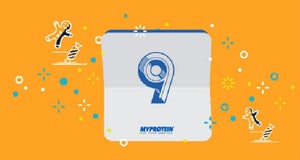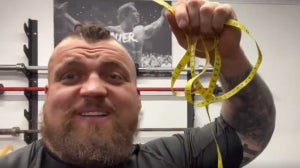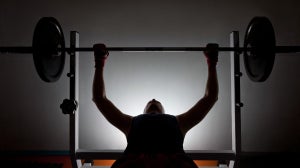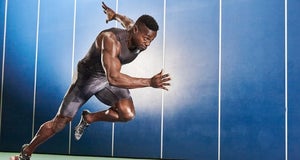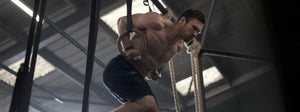
The shoulder muscles consist of the Deltoids and the Rotator Cuff Group. The Deltoids are the muscles that can be seen on the outside of the body, whilst the Rotator Cuff Group is found within the shoulder joint itself, providing structural support and allowing the shoulder to perform many functions.
The shoulder joint itself can be considered as the most mobile joint on the human body. It allows for flexion, extension, abduction, adduction, rotation, and circumduction. Whilst this allows the shoulder to move in almost any range of motion, it also proves that the shoulder is especially susceptible to injury, if the muscles are not trained correctly and efficiently!
Deltoids | Anatomy & Functions
In terms of aesthetics and proportion on a physique, the Deltoids provide width to the upper body, and contribute to the ‘V-taper physique,’ of which many desire, due to the waist appearing smaller.
Not only do well-developed Deltoids look good, a strong and healthy Rotator Cuff Group can aid greatly in preventing injury
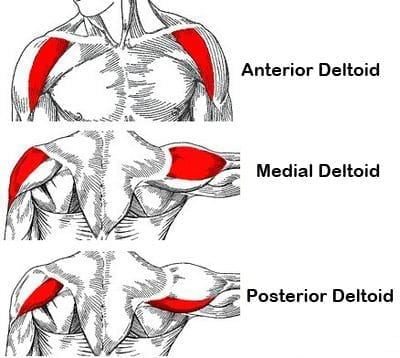
The Deltoids consists of 3 parts/heads:
1) The Anterior Deltoid
2) The Lateral Deltoid
3) The Posterior Deltoid
Whilst all 3 heads share the same insertion, they have different origin points.
The Anterior Deltoid
The Primary function of the Anterior Deltoid is shoulder flexion, i.e raising the arm upwards. This function is isolated in exercises such as the Dumbbell Front Raise.
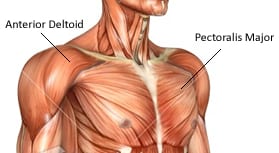
The Anterior Deltoid is also involved in Transverse Adduction; meaning bringing the Humerus across the mid-line of the body. This also involves the Pectoralis Major muscle.
The Anterior Deltoids are heavily involved in Chest Pressing and Chest Fly exercises, i.e. Flat Bench Press, Incline Dumbbell Press, Dumbbell Chest Fly etc. This means that in most people, direct shoulder work may not be necessary to achieve sufficient development of the Anterior Deltoid!
NOTE:
Most shoulder imbalances are subject to over-development of the Anterior Deltoid, therefore the shoulder must be kept balanced in order for the joint to be healthy. However, compound exercises that target the Anterior Deltoid provide functional benefits and muscular hypertrophy; therefore it may be important to perform them!Exercise #1)The Dumbbell Overhead Press & Barbell Overhead Press
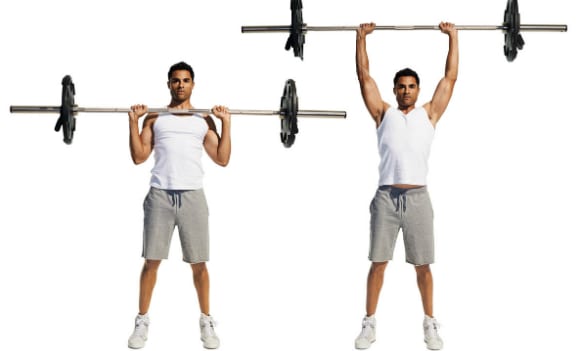
These are 2 compounds exercises that target the Anterior Deltoid, as well as the Triceps. They both allow for heavy loads to be placed upon the muscles, and can aid greatly in overall pressing strength. These exercises can be a powerful tool to Powerlifters looking to increase their strength on the Bench Press.
However, when it comes to Bodybuilding, there are alternative exercises that isolate the Anterior Deltoid specifically, which may be important if the Anterior Deltoid is underdeveloped – although this is highly unlikely due to the involvement of the Anterior Deltoid muscle in Chest Pressing exercises.
Exercise #2)The Single-Arm/Normal Cable Front Raise
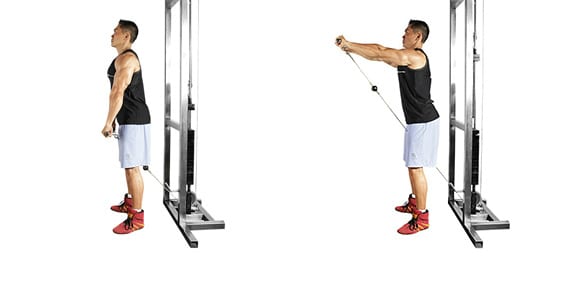
? Using a cable to perform this exercise instead of a Dumbbell allows for the constant tension being placed directly onto the Anterior Deltoid.
The Lateral Deltoid
This is the muscle head of the Deltoids that contributes greatly to the overall width of the upper body structure.
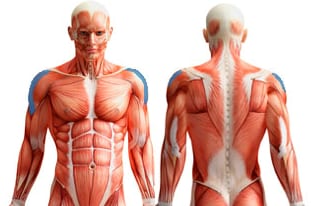
Achieving development of this muscle is incredibly important to bodybuilders, and anyone who trains for aesthetics and to look good.
The function of the Lateral Deltoid is shoulder abduction. This involves raising the arm to the side of the body. The function is isolated in exercises such as the Dumbbell Lateral Raise.
The Lateral Deltoid is not involved in any other exercise; therefore it is very specific in its training, due to the specific range of motion of which the Lateral Deltoid allows for. Whilst underdevelopment of the muscle may not cause any functional problems (such as underdevelopment of the Posterior Deltoid) it is still important to train the muscle to maintain a balanced and proportional shoulder joint.
Exercise #3)The Cable Lateral Raise
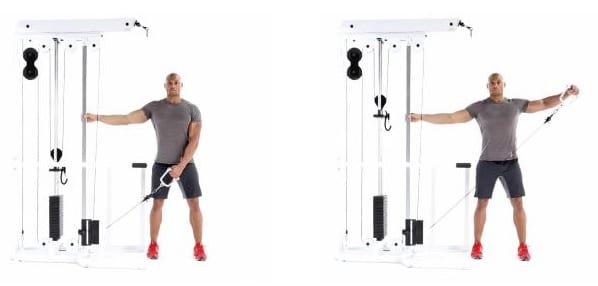
The Cable Lateral Raise is performed using a cable machine, at a low-level. The cable is raised, one arm at a time, out to the side of the body, within the mid-line.
? This exercise allows for continuous tension to be placed onto the Lateral Deltoid, due to the circular nature of the resistance from the cable. This makes the Cable Lateral Raise greatly superior to the Dumbbell Lateral Raise, and the resistance of the Dumbbell Lateral Raise is placed directly downwards due to gravity, leading to the full tension not being placed onto the muscle.
? The shoulder should be kept in a neutral position or slight internal rotation when performing this exercise.
The Posterior Deltoid
This muscle can be considered the most important in terms of structural stability of the shoulder joint. It is very common that the Posterior
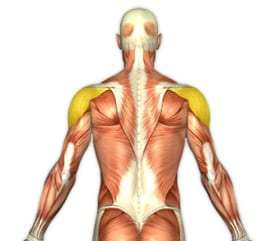
...This, however, is not true. The Posterior Deltoid is not involved in Back exercises as near as much as the Anterior Deltoid is involved in Chest exercises. This may lead to severe structural issues of the shoulder joint.
The muscle originates in the scapular spine, of its underside part.
The function of the Posterior Deltoid is Transverse Abduction. This involves bringing the arm out from in front of the body, to the mid-line of the body. This function is the opposite to that of a Chest Fly motion, and is targeted in an exercise called a Posterior Deltoid Reverse Fly. This movement is often performed using a Reverse Fly Machine.
Exercise #4)The High Cable Row
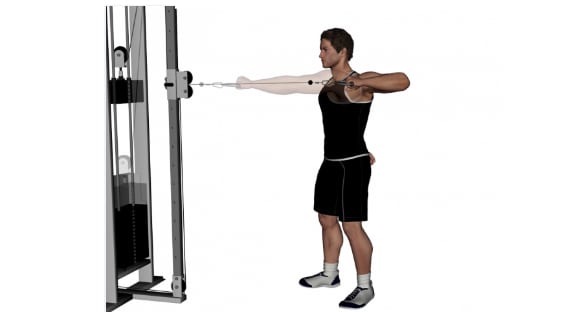
This is a compound exercise that directly targets the Posterior Deltoids, through transverse abduction, as well as the trapezius muscle through scapula retraction. A rope attachment can be used, or a straight bar, depending on personal preference - or as shown above as a one-armed high cable row for isolation.
? The exercise is performed using a cable machine, set at a level that is in-line with your clavicle (collar bone.)
? Stand with torso straight and core tight.
? Exhale whilst pulling arm straight back and squeeze shoulders on contraction.
? Inhale whilst arm moves forward - preparing for the next rep.
Exercise #5)Cable Reverse Fly/Reverse fly
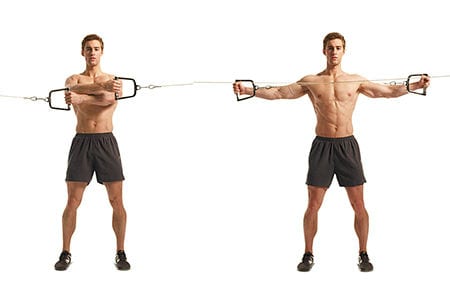
? The Cable Reverse Fly allows for each Posterior Deltoid of each shoulder to be targeted unilaterally. This can prevent strength imbalances between the two. However, the Reverse Fly Machine allows for both Posterior Deltoids to be trained at the same time; bilaterally.
? Stand with torso straight.
? Exhale whilst pulling arms straight back and squeeze shoulders on contraction.
? Inhale whilst arm moves forward - preparing for the next rep.
Exercise #6)Cable Face Pulls
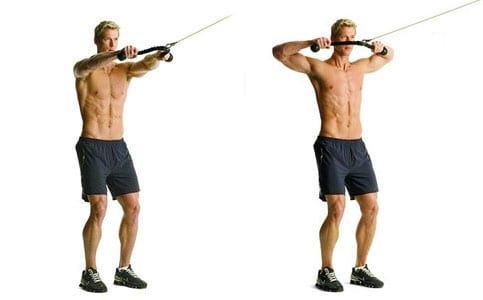
As well as training the Posterior Deltoids, this exercise also places a lot of tension onto the external rotators of the shoulder, within the Rotator Cuff group. This exercise can be important due to weakness in the external rotators. This is due to over-development of the internal rotators of the shoulder, which are involved in exercises such as the Barbell Bench Press and variations of the Chest Fly.
? Having a dedicated exercise that trains the external rotators can have many benefits, as it can help prevent internal rotation of the shoulders and can provide a balance within the Rotator Cuff group.
Example Workout Plan
| Exercise | Sets & reps |
| Dumbbell/Barbell Overhead Press | 1-3 x 6-12 reps |
| The Single-Arm Cable Front Raise | 3-5 x 6-12 reps |
| Cable Lateral Raises | 4-6 x 6-15 reps |
| High Cable Rows | 3-5 x 6-12 reps |
| Cable Reverse Fly/Reverse fly | 1-3 x 6-12 reps |
| Cable Face Pulls | 3-5 x 6-15 reps |
Take Home Message
To summarise, the majority of your training should be placed onto the Lateral and Posterior Deltoid, as these are the heads of the Deltoid that can easily lead to underdevelopment if not trained sufficiently.
Enjoy your training!
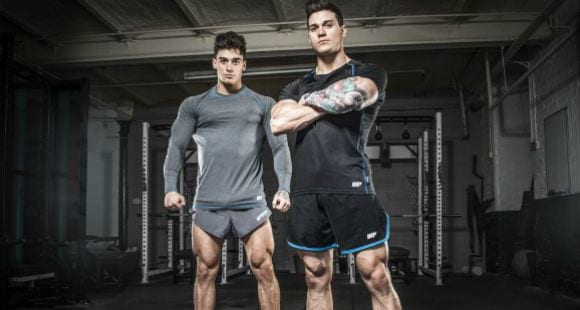
Whey ProteinLean muscle
CreatineStrength, Power
MaltodextrinEnergy
BCAA'sMuscle recovery
Our articles should be used for informational and educational purposes only and are not intended to be taken as medical advice. If you're concerned, consult a health professional before taking dietary supplements or introducing any major changes to your diet.

